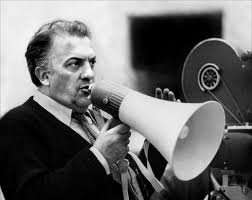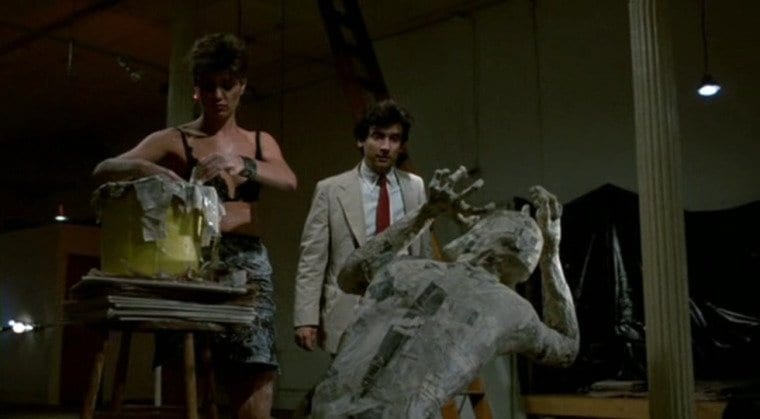The 1970s proved to be an interesting time for Federico Fellini and by extension, the other renegade filmmakers who were part of the bold and brazen European explosion happening to film during the 1960s. By the time the ’70s rolled up, Hollywood had not only taken notice of what was happening outside the U.S., but they were styling themselves after it. Everybody from William Friedkin, Brian De Palma, George Lucas, Martin Scorsese and Terrence Malick were excited by the sense of liberation which was on full display in these works.
One would think that by extension, the foreign directors would attempt to infiltrate Hollywood and claim back what was theirs or even emulate the movie-makers they admired, such as Stanley Kubrick and Alfred Hitchcock, but most of them stayed where they were most happy — outside the American film system.
Oddly enough, one of the leading fathers of the European movement, Federico Fellini, found the stories he wished to tell more closely resembled the films and feeling of one of his contemporaries, François Truffaut, than from anybody in America. One of the most obvious examples of this was his 1973 feature, Amarcord. This film earned Fellini a Best Director Oscar nomination, a nomination which many believed might have gone to Steven Spielberg for Jaws instead. Ironically, in 1977, Truffaut — whose sensibilities are all over Amarcord — appeared in Spielberg’s Close Encounters of the Third Kind, a movie for which the young U.S. director did receive a Best Director Oscar nomination.

Fellini closed out the ’70s with the small-scale Orchestra Rehearsal — another film which although comprised of many Fellini-esque touches could also have been directed by Truffaut. With Fellini’s next movie, however, there is no mistaking whose mind this sprang from.
The director’s first film of the 1980s was City of Women (La città delle donne), filmed at his beloved Cinecittà studios in Rome. Much like how Fellini’s Juliet of the Spirits has often been thought to be a gender reversal of his film 8½, City of Women can be viewed as a reversal of Fellini’s Casanova which featured Donald Sutherland as the famed lover/poet/musician/scientist.
City of Women begins on a train. Our hero, Snàporaz (Marcello Mastroianni), woken from the shaking of the cabin he’s in, finds himself sitting across from a stylish, leather-booted, mystery woman (Bernice Stegers) hiding her eyes behind large dark glasses. Fellini understood the impact of the male gaze before it entered social consciousness and with Mastroianni once again portraying the director’s alter-ego, this time leads by it. This projection of Fellini is older, greyer, slower and more foolhardy. We don’t know a thing about him besides his name, Snàporaz, and that he dresses in the same manner (black suit and tie) as Fellini’s earlier alter-ego’s — Marcello from La Dolce Vita and Guido Anselmi from 8½.
Snàporaz is immediately attracted to the stranger. So much so that when she gets up to use the train lavatory, he’s right behind her, closing that door shut and then running his hands all over her as she plays along — for a little bit.
The train stops in the countryside where the woman departs with Snàporaz chasing after her. Perhaps his aim is to make love to her right there in the tall forest grass. She doesn’t see that happening and after a bit of teasing him while he’s up against a tree, she slips away and into a nearby hotel, the Miramare, where he, of course, follows her. He then finds himself in the middle of a feminist convention (kudos to casting director Liliana Betti for her work in finding so many wonderful women to fill all these parts). Poems are read and slides are shown, which angrily depict the issue of male dominance and hierarchy and realizing that this is not the place for him, Snàporaz decides it’s high time to leave this community but it’s not made easy for him.
He is “rescued” by Donatella (Donatella Damiani), a nurturing, lively young woman on roller skates who takes pity on the frightened, lost soul — but his odyssey is far from over. After escaping the circle of roller-girls, Snàporaz lands in a furnace room with a caretaker who offers him a ride to her nearby farm. There, the woman attempts to seduce him. Here he has now become the sexual object — nothing more than a being to satisfy the woman’s carnal lust which is exactly how he saw the woman on the train. Naturally, the encounter disturbs him, so after he escapes, he flees to a roadside where he is picked up by a group of punk girls. The punk/car sequence is one of the movie’s more dazzling sequences as the only available light is courtesy of high beam headlights along the pitch black roads.
While the girls thrash their heads about to the electronic hybrid of Italian pop, Snàporaz sinks further into the seat, very much out of place among those young vixens. This leads to him bolting and standing by the empty road. Not since Steven Spielberg’s Duel has being pursued by an automobile seemed so menacing.
Snàporaz finds refuge in a large mansion owned by an old friend of his, Dr. Sante Katzone (although the Blu-ray version I own displayed this character’s name as Xavier Zuberkock, which I understand is the case for international versions of this movie). Katzone (played with gusto by Ettore Manni) is hosting a party celebrating his 10,000th sexual female conquest. Boorish and crude, Katzone’s behavior pales to the immature pursuit of the woman from the train at the beginning of this movie displayed by Snàporaz. It’s at this point where the portrait of Snàporaz shifts — especially as he roams about the mansion only to discover his wife, Elena, among Katzone’s guests.
The sight of Elena (played by Anna Prucnal) forces Snàporaz to confront and admit his failings as a husband, notably his selfishness and inability to mature. These moments reminded me of similar scenes in La Dolce Vita and 8½ where the main character (again in both instances portrayed by Mastroianni) is called out by the main women in their lives (the women played both times by Anouk Aimée, who was considered for the role of Elena before Prucnal was cast). The females in these three Fellini films are sharper, smarter and more intuitively aware of what is actually happening than any of the male “heroes” are. The men’s lies do not work — the women know these men too well and of the emptiness within these relationships, while the men carry on blissfully unaware of the void they are responsible for.
Snàporaz realizes this when he spots Donatella also in attendance at the party. Did she tell Elena about everything he’s been up to that day? Perhaps, although she doesn’t let on. Soon, Donatella (and her sister) are joined by Snàporaz in a dance number. Naturally, much like Guido’s harem of women in 8½, these two women are acting out one of Snàporaz’s fantasies, which is illustrated by the fact the two women are now wearing very skimpy outfits.
The women become his fantasy and in this fantasy, he is the dashing, lively entertainer which is quite the reversal from everything he was up to at this point in the film. Was it the sight of Elena that manifested this change? Was Snàporaz reminded that at one time, he was dashing and entertaining and engaging enough to warrant a woman such as Elena falling for him? It’s quite possible as the next scene has Snàporaz finally retiring to bed — not with the bikini-clad dancing sisters, however, but by himself.
He is joined by Elena, who has her way sexually with him while a storm rages outside and sounds become prominent under his bed. Crawling down to inspect, Snàporaz finds himself at the top of a large carnival slide where he is greeted by three “hosts” who invite him to take a “ride” through his memories of sexual experiences from his childhood. This sequence is one of the more lavish and fantastic among Fellini’s career and that is saying something. This is cinema at it’s most visually hypnotic and this is a good time to mention the astoundingly brilliant production designer, Dante Ferretti. Ever since this movie was released, Ferretti has worked numerous times with Coppola, De Palma and most notably with Scorsese, even as recently as 2016 for Silence, but Ferretti has never matched himself in terms of unbridled, imaginative visual design.
Snàporaz’s erotic memories from the past include spying on a woman changing into a bathing suit on the beach, a widow shaking her rear while polishing a grave marker and a pair of sexy leather-clad bikers. Most notably is a brief sequence involving a crowd of adolescents lying under a large blanket and pleasuring themselves to a large movie screen with the images of Greta Garbo and Mae West flashing before their mesmerized eyes. Immediately, we are reminded of similar moments which prominently figured in Amarcord. By revisiting these memories, is Snàporaz longing to return to a more innocent time — one without angry feminism and scary punk girls? Was there a time where groping a stranger was an acceptable aspect of society to him? It seems that this world has gotten too scary for him and his only safety is offered in the forms of memories and fantasy. Here, he is in a world where both merge.
When he reaches the end of his ride, the memories are gone and now he must face a tribunal of women to answer for a lifetime of womanizing, unfaithfulness and failure to understand women. Other men are brought out to fight among women wearing ski masks. None of the men survive. To pay for his “crimes”, Snàporaz must climb a ladder which leads up to a basket under a large balloon of Donatella — the woman who protected him earlier and became his fantasy later. As he climbs and nearly reaches the balloon which would fly him to safety, the live Donatella shoots her balloon likeness down. Is this retribution for conjuring up the fantasy, bikini-clad Donatella after the maternal one displayed compassion for him earlier?
When she shoots at the basket under the balloon, the film ends right where we began with Snàporaz sitting in that same train car — only now he is sitting across from Elena, where they are then joined by the woman in the boots. The question now is was his odyssey merely a dream? If so, what did he take from it? Did the two women ignore him or toy with him? Before we can find out, the train carrying them enters a black tunnel and these questions will now remain forever unanswered, which is exactly how Fellini wanted it.
In re-watching City of Women for this article, I was struck by the similarities between this film and one which was released five years later — Martin Scorsese’s After Hours. Both movies feature lonely men who long to make a connection with a female they just happen to meet by chance. In trying to create that connection, they instead find themselves lost in a world determined to cosmically thwart that thinking through an absurd series of accidents and unfortunate coincidences — not to mention, just plain crappy luck.
A major difference being that in Scorsese’s tale, the hapless everyman at the center of that story, Paul Hackett (Griffin Dunne), is overall a genuinely decent guy who just wants to meet a nice girl. Fellini’s Snàporaz seems to be driven only by lust and the need to consume. When he chases after the woman on the train, we don’t know what he exactly wants or what’s compulsively driving him to chase after her other than his admittance that he can’t “let that go.” At their odyssey’s end, both men wind up exactly where they began and the audience wonders what they’ve learned. Has Snàporaz learned to not be so selfish in the future with and to the women in his life? Perhaps. As for Scorsese’s Paul, well perhaps the only thing he’s learned is that spending a quiet night at home by yourself isn’t always that bad.

I imagine watching City of Women in 2018 would have been different than in 1980. Would this film even have been made today? Would Fellini be attacked mercilessly for daring to make such a movie? Perhaps. Or he might be applauded for making a movie where the only two men of note are portrayed in less than flattering lights. Snàporaz is seen as a middle-aged horny old cad who should know much better. The fact that he is married, which is later revealed, only makes his behavior much more abhorrent. Dr. Katzone is portrayed as a gluttonous buffoon with a fat gut and course manners (he urinates all over his own large celebratory cake). In these terms, perhaps this movie would have an audience today (but then again, this aspect would most likely just upset an entirely different segment of today’s population).
Fellini, much like David Lynch, would note his nightly dreams and use them later as a reference for his art. Fellini would sketch crude cartoons of his dreams and was not shy about showing them to female journalists — with a warning first that they were rather crude and obscene. In addition to sketches, Fellini kept diaries which he would also call upon for ideas and inspiration for films. In fact, he often used to say, “I have a wonderful life at night in my dreams.” As we can see from City of Women, he wasn’t lying.

